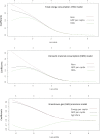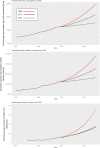Can the Framing of Climate Mitigation Actions into Government Policies Lead to Delivering Them? - Insights from Nepal's Experience
- PMID: 35460358
- PMCID: PMC9034080
- DOI: 10.1007/s00267-022-01643-6
Can the Framing of Climate Mitigation Actions into Government Policies Lead to Delivering Them? - Insights from Nepal's Experience
Abstract
Many low-income countries (LICs), including Nepal, endeavour to deliver climate mitigation by reducing greenhouse gas (GHG) emissions and achieving more sustainable resource consumption. However, their prospects of delivering on such goals alongside the rapid structural changes in the economy prevalent in the LICs are not clear. This research aims to better understand the underlying complexity in the linkage between the framing of climate mitigation actions into government policies and the prospects for their delivery. We use critical discourse analysis, post-structural discourse analysis, and thematic analysis of textual data corpus generated from government policies (n = 12) and semi-structured interviews (n = 12) with policy actors, such as government policymakers and private sector and non-government organisations' representatives. We also develop energy and material consumption and GHG emissions models to predict their values up to 2050 via the R tools and machine learning algorithms that validate the accuracy of models. Our findings suggest that the social context of policymaking creates a knowledge structure on climate mitigation which is reflected in government policies. The policy actors and their institutions exchange their ideas and interests in a deliberative and collaborative environment to prioritise policies for the energy, forest, and transport sectors to deliver climate mitigation actions in Nepal. However, the energy sector, together with the agriculture sector, has insufficient climate mitigation actions. Reflecting on the high proportion of biomass in the energy mix and the rapid rise in fossil fuel and energy consumption per capita-both of which are driven by the remittance inflows-this research suggests measures to reduce these in an absolute sense.
Keywords: Climate mitigation; Energy and material consumption; Energy transition; Greenhouse gas emissions; Low-income country; Remittance.
© 2022. The Author(s).
Conflict of interest statement
The authors declare no competing interests.
Figures






Similar articles
-
Greenhouse gas emissions reduction in different economic sectors: Mitigation measures, health co-benefits, knowledge gaps, and policy implications.Environ Pollut. 2018 Sep;240:683-698. doi: 10.1016/j.envpol.2018.05.011. Epub 2018 May 26. Environ Pollut. 2018. PMID: 29775945 Review.
-
Nepal's domestic material consumption-projection and causal impact of external financial inflows, services value-added, population, and economic growth.Environ Sci Pollut Res Int. 2022 May;29(22):33674-33697. doi: 10.1007/s11356-021-18050-9. Epub 2022 Jan 14. Environ Sci Pollut Res Int. 2022. PMID: 35028842 Free PMC article.
-
Greenhouse gas emissions in the Indian agriculture sector and mitigation by best management practices and smart farming technologies-a review.Environ Sci Pollut Res Int. 2024 Jul;31(32):44489-44510. doi: 10.1007/s11356-024-33975-7. Epub 2024 Jun 29. Environ Sci Pollut Res Int. 2024. PMID: 38951399 Review.
-
Greenhouse gas emission widens income inequality in Africa.Environ Sci Pollut Res Int. 2022 Jul;29(31):46691-46707. doi: 10.1007/s11356-022-18925-5. Epub 2022 Feb 16. Environ Sci Pollut Res Int. 2022. PMID: 35171416
-
Co-benefits, trade-offs, barriers and policies for greenhouse gas mitigation in the agriculture, forestry and other land use (AFOLU) sector.Glob Chang Biol. 2014 Oct;20(10):3270-90. doi: 10.1111/gcb.12591. Epub 2014 May 8. Glob Chang Biol. 2014. PMID: 24700759 Review.
References
-
- Agarwal B. Participatory exclusions, community forestry, and gender: an analysis for South Asia and a conceptual framework. World Dev. 2001;29:1623–1648. doi: 10.1016/S0305-750X(01)00066-3. - DOI
-
- Akçay S, Demirtaş G. Remittances and energy consumption: evidence from Morocco. Int Migrat. 2015;53:125–144. doi: 10.1111/imig.12202. - DOI
-
- Aryal K, Krishna H, Raj P, Maraseni T. Who shapes the environmental policy in the global south? Unpacking the reality of Nepal. Environ Sci Policy. 2021;121(July 2020):78–88. doi: 10.1016/j.envsci.2021.04.008. - DOI
-
- Asian Development Bank (ADB). (2021). https://kidb.adb.org/kidb/sdbsCountryView#se
Publication types
MeSH terms
Substances
LinkOut - more resources
Full Text Sources

